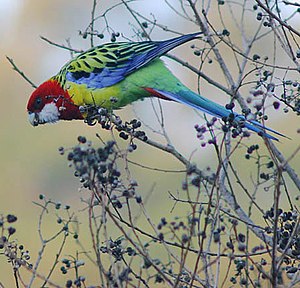Eastern rosella
| Eastern Rosella | |
|---|---|

| |
| Male in New South Wales | |
| Scientific classification | |
| Kingdom: | |
| Phylum: | |
| Class: | |
| Order: | |
| Family: | |
| Subfamily: | |
| Tribe: | |
| Genus: | |
| Species: | P. eximius
|
| Binomial name | |
| Platycercus eximius (Shaw, 1792)
| |

The Eastern Rosella (Platycercus eximius) is a rosella native to southeast Australia and Tasmania. It has been introduced to New Zealand where feral populations are found in the North Island [1] (notably in the northern half of the island and in the Hutt Valley) and in the hills around Dunedin in the South Island[2][3].
Description
The bird is around 30 cm long, with a red head and upper breast and white cheeks. The rest of the breast is yellow becoming more greenish toward the abdomen. The feathers of the back and shoulders are black with yellowish margins, giving rise to a scalloped appearance. The wings and lateral tail feathers are bluish while the rest of the tail is dark green. The female is similar to the male though duller in colouration.
The Eastern Rosella is found in lightly wooded country. It eats grass seeds and fruits. Breeding occurs in spring and early summer and up to seven white eggs are laid in tree hollows.
Taxonomy
The Eastern Rosella was named by George Shaw in 1792. It is sometimes considered a subspecies of the Pale-headed Rosella (P. adscitus). Three subspecies of Eastern Rosella are recognised: diemenensis (eastern Tasmania), eximius (Victoria and southern New South Wales), and cecilae (northern New South Wales). Platycercus eximius cecilae is also called the Golden-mantled Rosella (or GMR).
-
Eastern Rosella at Hobart Domain
-
Eastern Rosella at Domain (grazing)
-
At Buffalo Zoo, USA
As pets
The Eastern Rosella is sometimes kept as a pet. These birds are desired for their beautifully coloured plumage. They are intelligent creatures, which can be trained to whistle a wide repertoire of tunes and may even learn to speak a few words or phrases. Rosellas can make good companion parrots; however, they require a great deal of attention and many toys to satisfy their need for social interaction and mental stimulation. These birds do not always adapt to life as a family pet and even hand-raised birds may never become fully domesticated. Generally, this species does not tolerate “petting” or “cuddling” and is apt to bite in response to this type of handling. Many people believe that Rosellas are best housed in large aviaries that enable them to fly freely with minimal human socialization. Despite these difficulties, many people enjoy the Eastern Rosella as a beautiful pet with a strong, feisty personality.
References
- ^ Falla RA, Sibson RB & Turbot EG (1966) A Field guide to the birds of New Zealand. Collins, London (ISBN 0-00-212022-4)
- ^ Te Ara: The encyclopedia of New Zealand online
- ^ Notornis (Ornithological Society of New Zealand journal), 2002
- Template:IUCN2006 Database entry includes justification for why this species is of least concern
- Simpson, K and Day, N,. Field Guide to Australian Birds 7th edition, 2004 ISBN 0-670-04180-7
- Forshaw, Joseph M. & Cooper, William T. (1978): Parrots of the World (2nd ed). Landsdowne Editions, Melbourne Australia ISBN 0-7018-0690-7




